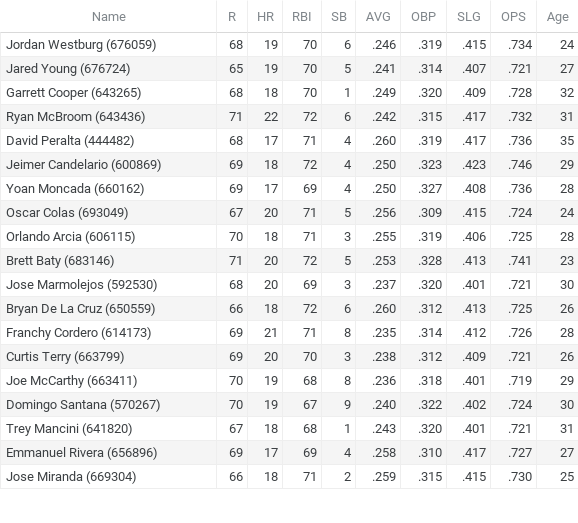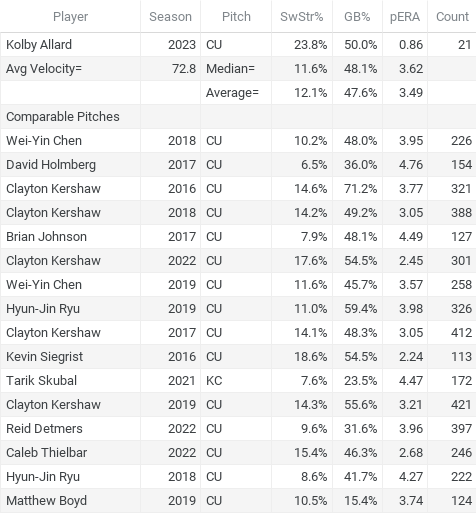Big Kid Adds (Week 15)
While the NFBC Main Event garners most of the attention, there are a handful of leagues with even a larger entry fee ($2.5K to $15K). They get originally named “High Stakes Leagues” and this year there are nine of them. With so much money on the line, these fantasy managers are going to try to gain any advantage. Most of the time, these managers will be a week or two ahead of everyone else on their adds. Here are the players and some information on the ones added in four or more of these leagues.
Batters
Jordan Westburg (9): In AAA, the 24-year-old was on fire by hitting .295/.372/.567 with 18 HR and 6 SB. Our depth chart projections had him hitting .241/.315/.402. A big difference. When I ran the Steamer600(ROS) comps, I ended up with:

It’s not an inspiring list with Orlando Arcia being the best infield comp. Arica needed an everyday job and so will Westburg.
Besides in one league where I needed some middle infield help, I tempered my bids in order to save my FAAB for more of a difference-maker.
Jean Segura (6): While struggling to be productive this season (.203/.273/.255, 2 HR, 6 SB), Segura just came off the IL, is playing every day, and qualified at two positions (2B and 3B). Just the best available option.
Nick Madrigal (6): Even before going on the IL, Madrigal was about to see his playing time limited with Patrick Wisdom coming off the IL. I’m pretty sure Madrigal gained the attention of some managers with his 40 PA, 4 SB, and a .361 over the previous two weeks (setting on NFBC). Madrigal would need to have full-time at-bats to be relevant and that wasn’t guaranteed.
J.P. Crawford (5): Weekly projections loved Crawford this week with seven games and six against righties. At Razzball, he was the week’s 103rd-ranked player and readily available.
Isiah Kiner-Falefa (5): Beginning last Wednesday, he had a streak of seven straight starts, but four of the first five were against lefties. It wasn’t obvious that his playing time would continue, but luckily for his managers, Billy McKinney got hurt and stayed in the lineup.
On the season, Kiner-Falefa is hitting .262/.308/.393 with 5 HR and 9 SB over 199 PA. A fine option, especially for stolen bases, again, if he continues playing every day.
Will Benson (4): While Benson has been productive (.282/.378/.447, 3 HR, and 6 SB in 119 PA), he’s on the strong side of a platoon. This week, he was scheduled to face five righties (2/3). With most of these leagues being 15-teamers, it’s likely he was just the best available outfield option on the wire.
Owen Miller (4): Miller has cycled from being a bench bat, to a part-time role, to starting each game. Right now, he’s in a part-time role. Coming into the weekend’s bids, he has started in six of the last ten games. While Miller has been surprisingly effective when playing (.285/.327/.404 with 4 HR and SB in 245 PA) but it’s tough to be fantasy relevant with around 50% playing time.
I could see two reasons behind the adds. First, teams could be desperate for stolen bases and Miller was what they felt was the best option. The other was that with Luis Urías demoted to the minors, more playing time would open up (started five of seven games).
Oscar Colás (4): It wasn’t obvious that Colas was going to be promoted on Monday but several signs pointed that way including Colas’s AAA production (.293/.358/.508, 9 HR, 1 SB in 212 PA). Go up and look at the Westburg comps and there is Colas. And Colas was added at fraction of the cost. Colas might get a nice run with his first start being back against a righty and Gavin Sheets, who usually faces righties, was on the bench.
Jared Young (4): Another comp to Westburg. The deal is that it doesn’t seem like Young will be getting full-time at-bats with the Cubs and only be a deep-league contributor.
Starters
Kolby Allard (9): For his career, Allard has a 5.94 ERA with just a 7.5 K/9 and a 1.40 WHIP. He changed that perception in just 10 IP going into the weekend and five more on Tuesday. Even with his fastball velocity 1 mph down from his career average, his strikeout rate is over 10 K/9 in both the minors and the majors. And he has kept his walks under control (2.7 BB/9 in AAA, 1.9 BB/9 in the majors) with a 32% Ball% (equivalent of 1.9 BB/9).
The biggest change from previous seasons is that he’s backed off his fastball usage (career 48% usage, 2023 42%). Maybe because he’s not as predictable with it, the pitch improved from a respectable career 8% SwStr%, but up to a 15% SwStr% this season.
Additionally, he’s featuring a new curve (14% SwStr%, 66% GB%). The comps on the pitch are basically Clayton Kershaw and a few other guys.

Additionally, he threw a cutter (9% SwStr%) and a few changes (8% SwStr).
Finally, the Braves aren’t letting him go late into games by facing 18 batters (71 pitches) and then 20 batters (74 pitches).
While Allard might be out of a job in a couple of weeks, he’s worth taking a stab in the hope he stays close to keeping up this level of production.
Keaton Winn (7): Before Winn’s Tuesday start, he had a 3.50 ERA (4.28 xFIP) but jumped to a 4.09 ERA (4.41 xFIP) after allowing 3 ER over 4 IP. I was intrigued with Winn because of his 59% GB% and two decent pitches, splitter (12% SwStr%) and four-seamer (16% SwStr%). Also, he mixes in a sinker (2% SwStr%, 63% GB%). With his overall 11% SwStr%, that should equate to 22% K%, not his 15% K% so there might be some strikeout upside.
One of his better traits is his control as seen by this 2.1 BB/9 and 35% Ball% (equivalent of 2.6 BB/9). Overall, he’s interesting but doesn’t look to be a difference-maker.
Kyle Wright (6): The news was that Wright was that he supposed to return around the All-Star break but he hasn’t started any rehab games. Since these adds, there was another bit of news that has him returning in late August.
RHP Kyle Wright (right shoulder inflammation)
Expected return: Second half of August
Wright was cleared to begin a throwing program on June 15. But he is still likely at least two months from making all the necessary preparations to rejoin Atlanta’s rotation. He has been sidelined since early May, when an MRI showed a right shoulder strain but not any significant tears. (Last updated: June 15)
I’m sure there is some better news out there, but I’m not able to find it.
Matt Manning (5): While Manning was a highly-touted prospect (9th overall pick, 17th overall according to 2020 Baseball America), he has struggled in the majors. I’ve written up Manning twice in the past week and here are both takes.
Waiver Wire Report

Mining the News

I believe if it wasn’t for the prospect ranking there would not be any demand for him.
Graham Ashcraft (4): Ashcraft came off the IL and his last start was one of his season’s best (6.2 IP, 7 K, 2 BB, and 1 ER). While there might be some classification issues with his pitches, he cut the usage of his cutter (7% SwStr%, 56% GB%) and bumped up his slider (15% SwStr%, 33% GB%) usage. Ashcraft’s issue is that his sinker has been worthless (4% SwStr%, 46% GB%, 1.056 vsOPS).
Effectively, he throws just two pitches and this can be seen when he faces a lineup each additional time.
TTO: ERA, xFIP, K%-BB%
1st: 3.73, 4.30, 22%
2nd: 8.10, 4.85, 6%
3rd: 9.68, 5.01, 5%
Finally, he’s just on the edge of being relevant and walking too many batters (3.7 BB/9 in 1H, 4.2 BB/9 in June). He needs a few things to improve to become a relevant pitcher.
Relievers
None… again.
Jeff, one of the authors of the fantasy baseball guide,The Process, writes for RotoGraphs, The Hardball Times, Rotowire, Baseball America, and BaseballHQ. He has been nominated for two SABR Analytics Research Award for Contemporary Analysis and won it in 2013 in tandem with Bill Petti. He has won four FSWA Awards including on for his Mining the News series. He's won Tout Wars three times, LABR twice, and got his first NFBC Main Event win in 2021. Follow him on Twitter @jeffwzimmerman.
How accurate/valuable are Razzball’s weekly player projections?
How useful are any player projections? They are always very conservative. Ronald Acuna has a .427 wOBA, statcast says a .463 xwOBA, while the Zips projection sits at .377. What is that last number useful for?
Raw projections are your best bet for forecasting any given player because on average you’re better off betting on regression toward the mean.
But the main diagnostic value of projections comes from comparing a player’s projections relative to others for context. In the case of Acuna, his preseason ZiPS projection may “only” have a .377 wOBA but that was tied for the 7th-highest projected wOBA in MLB. However, given random variation over the course of a baseball season, the most positive and negative outcomes are more extreme because raw projections assume regression for everyone. In the case of wOBA, this means the 7th-highest wOBA has averaged .395 (ranging from .381-.405) over the past 5 full seasons.
“you’re better off betting on regression toward the mean”
What mean? An average of mere mortals? Acuna is 25 and likely still getting better. Statcast says he would be undervalued in a trade based upon his 2023 production to date. Zips says the exact opposite, that he would be overvalued in that same trade.
Statcast is giving us meaningful information as to whether Acuna is likely to regress or not (he’s not). Zips is showing us what regression might look like if it happened. The former is clearly of value, still struggling to figure out what the latter does for me.